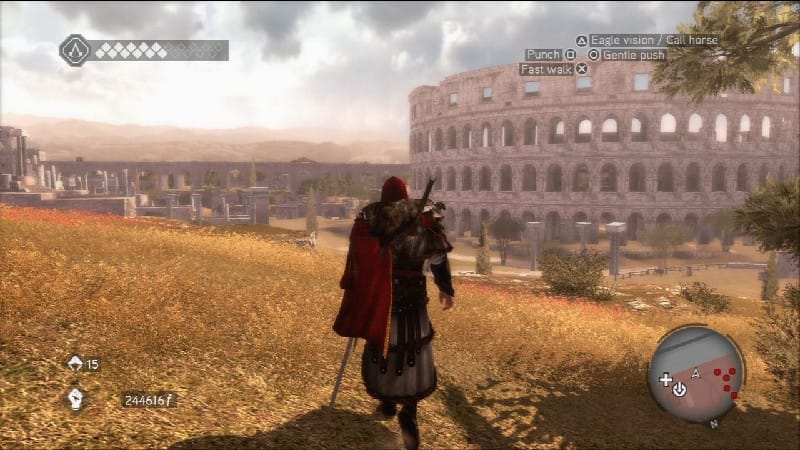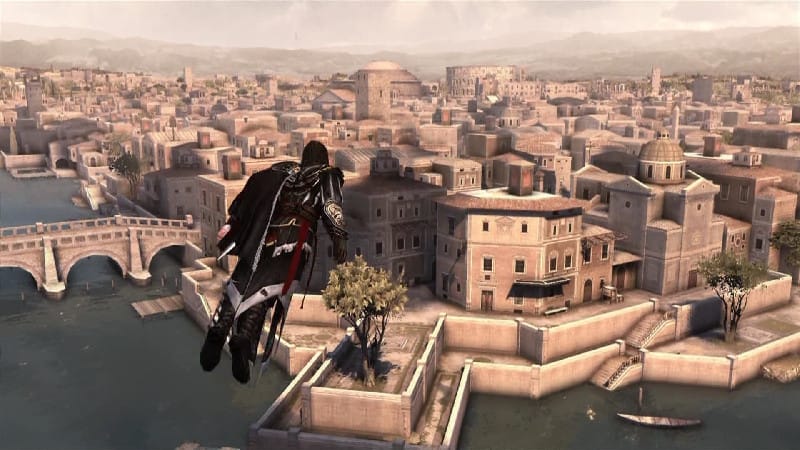
(Review archived from February 24, 2015)
Assassin’s Creed: Brotherhood is the second chapter in the ongoing saga of the inimitable assassin Ezio Auditore. In many ways this game dials in the scope of the story of Ezio while continuing to refine and expand upon gameplay elements present in the Assassin’s Creed series.
The story in Brotherhood picks up immediately where Assassins Creed II (henceforth referred to as AC2) left off. I’ll avoid spoilers, but if you complete AC2, and are wondering what happens next, it’s worthwhile to immediately play at least the first chapter of Brotherhood while the events of AC2 are still fresh in your mind. As I mentioned, the story in Brotherhood dials back the grandeur and epic nature of the story in AC2. Whereas the story in AC2 takes place over the course of a 10 year timespan occurring all over Italy, Brotherhoods plays out over a comparably meagre 4 years and only in the location of Rome. As a result Brotherhood loses some of that epic sense of scale we saw in the second game. Assassins’s Creed 2 introduced us to Ezio in a tale of loss, struggle, and ultimately redemption within a general narrative framework that (more or less) follows the traditional structure of the Heroes Journey. For better or worse the narrative structure in Brotherhood is more or less flat; the Ezio we see at the beginning to the game is still the same old Ezio we see when the credits roll. Admittedly it would have been a tall order for Brotherhood to raise the stakes for Ezio relative to the events in AC2. Unfortunately this leaves the events that transpire in Brotherhood feeling a bit like an epilogue to the ‘main story’ occurring in AC2.

In Brotherhood we once again find ourselves fighting the Borgias although these particular members of the family seemingly pop up from nowhere. From a historical perspective it makes sense that these Borgias would have been a threat to the fictional world of Ezio, but in terms of gameplay it would have been nice to at least have some reference to these folks in AC2, so as to maintain series continuity (granted I do understand this sort of series planning doesn’t often happen that far in advance). The main Borgia from AC2 does makes an appearance in Brotherhood as well, but it’s only slightly more than a couple of cameos. After all the time spent in AC2 tracking this man down, Ezio actually has very little to do with how that thread resolves itself. So that’s a bit disappointing. As it is the newly introduced Borgias wind up feeling like the “bad guys du jour”. The motivation for fighting them is provided clearly enough; it’s just the enemies themselves seem to be randomly inserted into the mythos (unless you were already acquainted with the history of the Borgias in which case, yes I suppose this decision makes total sense.)
So let’s talk about gameplay, because for the most part it is absolutely brilliant in Brotherhood. Once again we are treated to the delightfully smooth responsiveness we saw in AC2, and maybe it’s just me, but I feel like general mechanics and responsiveness have been even further improved upon here. I didn’t have nearly as many moments in which I felt Ezio jumped in completely unexpected directions. Wall jumps are smoother and easier to execute reliably. Not only that but the new gameplay elements introduced in Brotherhood, make the game all that much more enjoyable. Horseback combat is the best that it’s ever been in the series, and horseback assassinations feel extremely satisfying. The introduction of kill streaks makes standard combat even more dynamic and interesting. The crossbow is a fantastic addition for stealth kills at a distance. And then of course there is the titular Brotherhood itself. The ‘game within the game’ of building and managing a stable of Assassin’s under your command is enjoyable and well executed. Once you have a few talented assassins at your beck and call, it simultaneously introduces some game breaking elements and counterintuitively an undeniable feeling of exhilaration that comes with having a badass ninja posse at your disposal. You’d rather not deal with the gate guards in your way? Just whistle for your homeboys to jump in with blades flashing and smoke bombs flying. Don’t feel like slugging it out with charging cavalry? Call in an arrow storm. The brotherhood introduces a really fun mechanic to play around with, which actually does help to further the narrative of Ezio transitioning from rank and file soldier to master assassin within the order.

So while there is an overwhelming amount of good involved in terms of gameplay, there’s also a dash of the questionable. This is the first game in the series to introduce the concept of ‘memory synchronization’. Essentially this means that you have to play missions in a certain way, or meet certain objectives during the mission, to reach full synchronization (read: full completion percentage). Sometimes the full synchronization criterion makes sense. “Kill only the main target” or “Kill your target with the hidden blade” for example. Sure, that all sounds reasonably assassin-ish, and I can buy in to that. But sometimes the goals feel tacked on and arbitrary at best (“Kill at least three enemy types with their own weapon “, ” Kick your target”), and at worst they introduce an artificial sense of difficulty that would not exist otherwise (“Do not take damage while in the tank. ” … a tank which happens to be an unresponsive heap of fetid frustration. That’s right Leonardo, if you’re reading this; your tank is more worthless than a bag of farts at the bank). While the Order of Assassin’s preaches that, “Nothing is True, Everything is Permitted, the game itself tells you in no uncertain terms that, “No in fact you’re only permitted to accomplish this objective in one specific prescribed way”. It’s not that memory synchronization is game breaking or anything, but it does take some getting used to (or potentially a lot of getting used to if you’re going for 100% completion).
Lastly be aware that there is a lot to do in this game. This can be good or bad depending on how you feel about “artificially extending the experience”. So you’ve finished the story? I don’t think so partner, go help Leonardo with this whole War Machine thing. You’re done with that? Better figure out what the Cult of Romulus is up to! Romulus is in remission? Better go help some courtesans now! Whoa, don’t forget about those regression memories with Maria! Have you completed any guild challenges? Well get on it! Don’t forget to explore modern day Monteriggioni! No wait, where are you going?! You need to find and solve the Mystery of the Glyphs! And on and on … Personally I don’t mind this sort of thing. AC: Brotherhood is a fun world, and it’s fun to just goof around while completing some missions at the same time. On the other hand, if you feel like the description above sounds like a grinding slog tacked on purely for the purpose of lengthening the game, well you might have a bad time in Brotherhood (unless you opt to ignore side missions completely which is also perfectly valid)

Overall Assassin’s Creed: Brotherhood effectively expands and builds upon the Assassin’s Creed universe with some really great gameplay choices. While the story lacks some of the overarching grandeur we saw in AC2, it is still a nice expansion upon the story of Ezio and his exploits in Rome.
Leave a Reply